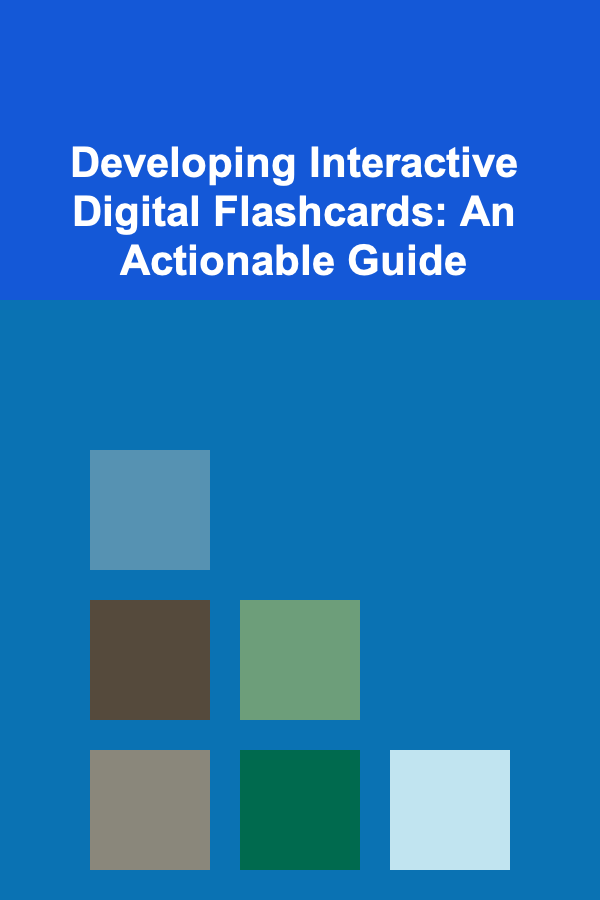
Developing Interactive Digital Flashcards: An Actionable Guide
ebook include PDF & Audio bundle (Micro Guide)
$12.99$11.99
Limited Time Offer! Order within the next:

In today's fast-paced learning environment, digital tools are increasingly becoming essential for students and educators alike. One of the most effective tools for enhancing memory retention and learning is digital flashcards. Unlike traditional flashcards, interactive digital flashcards offer a dynamic and engaging way to reinforce knowledge through multimedia and immediate feedback. This actionable guide will walk you through the process of developing interactive digital flashcards from conceptualization to implementation.
Understanding the Power of Flashcards
Flashcards have long been a popular method of studying due to their simplicity and effectiveness. The process of actively recalling information from memory is proven to strengthen neural connections and improve long-term retention. Digital flashcards enhance this concept by incorporating interactive elements such as audio, images, videos, and quizzes. They offer learners a more engaging experience than paper-based flashcards, which helps to maintain focus and motivation.
Benefits of Interactive Digital Flashcards:
- Active Recall: Interactive flashcards require learners to engage with the material actively, which is proven to increase retention rates.
- Multimedia Integration: Text, images, audio, and video can all be integrated, catering to different learning styles (visual, auditory, kinesthetic).
- Immediate Feedback: Users can get instant feedback, which helps in correcting misconceptions and reinforcing correct knowledge.
- Portability: Digital flashcards can be accessed on smartphones, tablets, and computers, allowing students to study anytime and anywhere.
- Gamification: Many interactive digital flashcard tools include game-like features such as points, badges, or levels to enhance motivation.
Define the Purpose and Scope of the Flashcards
Before diving into the technicalities of creating interactive flashcards, it's crucial to first define their purpose and scope. Understanding why you're developing the flashcards and who will be using them will guide every decision you make.
Questions to Consider:
- What subject or topic will the flashcards cover? Are they for language learning, medical terminology, historical events, or math equations? The subject will dictate the design and types of interactions required.
- Who is the target audience? Are the flashcards for elementary school students, college students, or professionals? The complexity of the content and the level of interaction should match the audience's needs.
- What devices will be used? Will users be studying on mobile devices, laptops, or both? This decision will influence the design of the flashcards and their compatibility with different platforms.
- How will the flashcards be used? Will they be part of a self-paced study program, integrated into a classroom setting, or designed for group collaboration?
By answering these questions, you'll establish a clear direction for your interactive flashcards and ensure they are effective for your intended purpose.
Choose the Right Tools and Platform
Developing interactive digital flashcards involves selecting the right tools and platforms that can bring your vision to life. Fortunately, there are a variety of tools available, each with its own set of features.
Flashcard Development Tools:
- Anki: Anki is one of the most well-known flashcard tools, offering a spaced repetition algorithm to help users retain information over time. It supports multimedia elements such as images, audio, and LaTeX (for equations). However, it requires a bit of technical knowledge for advanced customization.
- Quizlet: Quizlet allows you to create flashcards that can incorporate images, audio, and even quizzes. It is user-friendly and can be accessed on various devices. It's particularly useful for creating flashcards for language learning and general study.
- Cram: Similar to Quizlet, Cram is an online platform that allows for the creation of flashcards. It also supports multimedia and offers features like live sharing and group study.
- Flippity: Flippity is a tool that converts Google Sheets into various flashcard formats. It allows for easy customization and interactivity, making it a great choice for educators looking to create flashcards for class.
- Custom Development (Web/App): If you require a more tailored solution or wish to add specific features like gamification or personalized feedback, you can build a custom web or mobile app. Frameworks like React or Vue.js (for web) and React Native or Flutter (for mobile) are commonly used for such tasks.
Considerations When Choosing Tools:
- Ease of Use: How user-friendly is the platform? Choose a tool that aligns with your technical skills or the skills of your team.
- Customization: Some tools allow for more customization (design, interaction, media integration) than others.
- Scalability: If you plan on creating a large set of flashcards or expanding in the future, select a platform that can handle scaling.
- Cross-Platform Compatibility: Ensure that your flashcards are accessible across devices and browsers for maximum reach.
Design Interactive Features
The key to creating engaging digital flashcards is incorporating interactive features that keep the user's attention and provide effective feedback. Here's how you can make your flashcards more engaging:
Interactive Elements to Include:
- Audio and Voice Recording: Incorporating pronunciation for language learning or auditory learners can improve the learning experience. You can also allow users to record their answers and compare them to the correct one.
- Images and Visuals: Add relevant images to the flashcards to support visual learning. For example, use pictures to represent vocabulary words, historical events, or scientific diagrams.
- Quizzes and Multiple-Choice Questions: Include follow-up quizzes after each flashcard to reinforce learning and test comprehension.
- Timed or Progress-based Challenges: Introduce a time element for users to answer questions, creating a sense of urgency or competition. Alternatively, track progress over time with a visual indicator such as a progress bar or score.
- Spaced Repetition: Incorporate a spaced repetition system (SRS), which presents flashcards at increasing intervals based on how well the user knows the material. This technique enhances long-term memory retention.
- Gamification: Introduce levels, points, badges, or rewards to make studying feel more like a game, which can increase motivation and make learning fun.
- Collaboration and Sharing: Allow users to share their flashcards with others, fostering collaboration and peer learning. This can be especially useful in group study settings.
Design Tips:
- Simplicity: Keep the design of the flashcards simple and intuitive. Avoid cluttering the screen with too much information.
- Responsive Design: Ensure that the flashcards are usable on both desktop and mobile devices. Responsive design allows users to have a seamless experience regardless of the platform.
- Engagement: Make the flashcards visually appealing with colors, images, and consistent branding. Aesthetically pleasing designs are more likely to hold users' attention.
Implementing Feedback Mechanisms
Feedback is a crucial element in the learning process. Digital flashcards provide an opportunity to give instant feedback, allowing users to immediately correct errors and reinforce correct responses. Here are a few ways to incorporate feedback into your interactive flashcards:
- Correct/Incorrect Feedback: Display immediate feedback when users answer a flashcard. For example, "Correct!" or "Oops, try again!" This helps learners gauge their understanding right away.
- Detailed Explanations: After a user answers a flashcard, provide a detailed explanation of the correct answer. This helps reinforce learning and clarifies any misconceptions.
- Streaks and Achievements: Offer badges, streaks, or points for consistent progress or correct answers. This can motivate users to keep going and continue practicing.
- Personalized Feedback: Use algorithms to provide personalized feedback, such as suggesting specific flashcards for review based on the user's previous answers.
Test and Refine the Flashcards
Once you've created your interactive digital flashcards, it's important to test them before releasing them to the wider audience. Testing helps you identify any bugs, user interface issues, or areas of improvement. Here's how to conduct effective testing:
- Beta Testing: Share the flashcards with a small group of users and gather feedback on the overall user experience, content accuracy, and interactivity.
- Usability Testing: Observe how users interact with the flashcards to identify any usability issues. Are the buttons easy to press? Is the content clear and concise?
- Analytics: Use analytics tools to track how users engage with your flashcards. Which cards are they spending the most time on? Which ones do they skip? This data will help you refine your design and improve learning outcomes.
Deploy and Maintain the Flashcards
After testing and refining your flashcards, you're ready to deploy them to your target audience. Whether you're releasing them on an educational website, app, or sharing them in a classroom, make sure the launch is smooth and well-communicated.
Ongoing Maintenance:
- Regular Updates: Periodically review the flashcards and update them with new content or improvements based on user feedback.
- Bug Fixes: Ensure that any bugs or glitches are promptly addressed to maintain a smooth user experience.
- User Engagement: Keep users engaged by adding new features, challenges, or content regularly to keep their interest high.
Conclusion
Developing interactive digital flashcards is an exciting and rewarding project that can significantly enhance the learning experience. By following this guide, you can create flashcards that are not only informative but also engaging and motivating. The combination of interactive elements, multimedia, and immediate feedback will help learners retain information more effectively and stay motivated throughout their learning journey. With the right tools and a thoughtful design, your interactive digital flashcards can become an invaluable resource for learners of all ages.
Reading More From Our Other Websites
- [Home Security 101] How to Prevent Home Break-Ins: Effective Tips for Keeping Intruders Out
- [Home Budget 101] How to Save Money on Home Decor and Still Achieve a Stylish Look
- [Star Gazing Tip 101] A Beginner's Guide to Identifying Stars and Planets from Within the City
- [Weaving Tip 101] Weaving as Meditation: Finding Calm and Creativity One Stitch at a Time
- [Polymer Clay Modeling Tip 101] Eco-Friendly Alternatives and Tips for Reducing Waste When Working with Sculpey
- [Personal Financial Planning 101] How to Save for Your Child's College Fund
- [Home Lighting 101] How to Use Light to Make Your Home Feel More Inviting
- [Personal Investment 101] Earning Passive Income by Creating AI-Powered Websites
- [Soap Making Tip 101] Shea Butter Secrets: Boosting Moisture in Your Handmade Soap
- [Home Space Saving 101] How to Double Your Space: Utilizing Bookshelves as Room Dividers with Integrated Storage

Budget-Friendly Ideas for Saving on Wedding Invitations and Stationery
Read More
How to Maintain an Organized Workbench in Your Garage
Read More
How to Use Wall Art as a Storage Solution
Read More10 Tips for Optimizing Your Life Insurance Expense Tracking System
Read More
10 Essential Tasks Before Closing Day: Home Buyer's Guide
Read More
10 Essential Estate Planning Expenses to Track (and Why)
Read MoreOther Products

Budget-Friendly Ideas for Saving on Wedding Invitations and Stationery
Read More
How to Maintain an Organized Workbench in Your Garage
Read More
How to Use Wall Art as a Storage Solution
Read More10 Tips for Optimizing Your Life Insurance Expense Tracking System
Read More
10 Essential Tasks Before Closing Day: Home Buyer's Guide
Read More